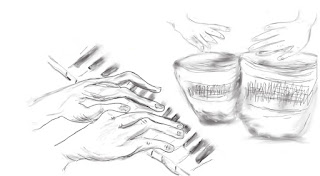Week 14 Phase 2 May 22nd 2018
Thinking touch, thinking haptic
My observation today reminds me of the significance of touch in childhood. From our immediate entry into the world from our mothers womb we are greeted by what Obstetriaian Fredrick Leboyer call "loving hands". The first connection and contact we have is an embodied, corporeal experience. These "loving hands" continue to be a vital source of our growth and development. The affective capacities of touch has been extensively researched by Tiffany Field among others, and show huge benefit to wellbeing in humans. Through infant massage the infant benefits by way of boosting the infants immune system, promoting a good sleep pattern, relieving colic, supporting muscle tone, skin tone, and premature infants gain weight more quickly (in SCBU).
With this in mind, as I observe the intricate finger movements and hand strokes (swirling, curling, twirling, tapping, threading, pulling and plucking and picking) the children make across Dave's fur and body (much to his sheer delight) I ponder what embodied memories they may be re-working and re-enacting. The caressing of mothers breast when taking in nourishment (physical and biological), the twirling of her hair during snuggles together, the reassuring feel of a fathers hand, or the feel of a favourite comforter such as a snookie blanket or teddy bear. Such sensory memories awakened and revitalised through the fur coat and warmth of a classroom dog.
This also links with philosopher Haraway and the curious question she asks "what do I touch when I touch my dog?"
We communicate so much through touch. It can be more powerful than words. It overcomes language barriers. It is indeed a force of nature.















